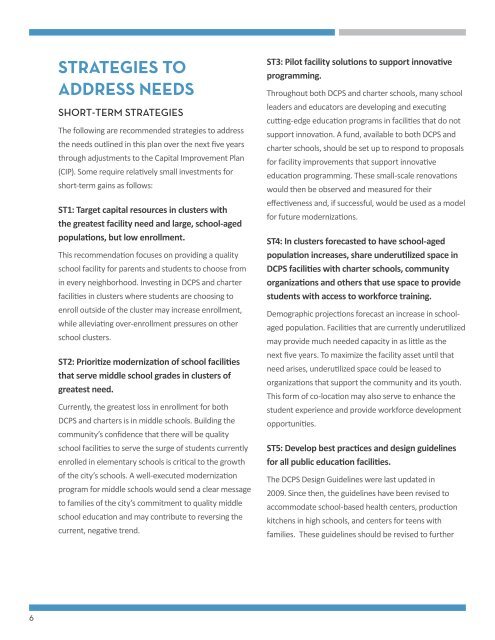DISTRICT COLUMBIA
DISTRICT COLUMBIA
DISTRICT COLUMBIA
Create successful ePaper yourself
Turn your PDF publications into a flip-book with our unique Google optimized e-Paper software.
6<br />
STRATEGIES TO<br />
ADDRESS NEEDS<br />
SHORT-TERM STRATEGIES<br />
The following are recommended strategies to address<br />
the needs outlined in this plan over the next five years<br />
through adjustments to the Capital Improvement Plan<br />
(CIP). Some require relatively small investments for<br />
short-term gains as follows:<br />
ST1: Target capital resources in clusters with<br />
the greatest facility need and large, school-aged<br />
populations, but low enrollment.<br />
This recommendation focuses on providing a quality<br />
school facility for parents and students to choose from<br />
in every neighborhood. Investing in DCPS and charter<br />
facilities in clusters where students are choosing to<br />
enroll outside of the cluster may increase enrollment,<br />
while alleviating over-enrollment pressures on other<br />
school clusters.<br />
ST2: Prioritize modernization of school facilities<br />
that serve middle school grades in clusters of<br />
greatest need.<br />
Currently, the greatest loss in enrollment for both<br />
DCPS and charters is in middle schools. Building the<br />
community’s confidence that there will be quality<br />
school facilities to serve the surge of students currently<br />
enrolled in elementary schools is critical to the growth<br />
of the city’s schools. A well-executed modernization<br />
program for middle schools would send a clear message<br />
to families of the city’s commitment to quality middle<br />
school education and may contribute to reversing the<br />
current, negative trend.<br />
ST3: Pilot facility solutions to support innovative<br />
programming.<br />
Throughout both DCPS and charter schools, many school<br />
leaders and educators are developing and executing<br />
cutting-edge education programs in facilities that do not<br />
support innovation. A fund, available to both DCPS and<br />
charter schools, should be set up to respond to proposals<br />
for facility improvements that support innovative<br />
education programming. These small-scale renovations<br />
would then be observed and measured for their<br />
effectiveness and, if successful, would be used as a model<br />
for future modernizations.<br />
ST4: In clusters forecasted to have school-aged<br />
population increases, share underutilized space in<br />
DCPS facilities with charter schools, community<br />
organizations and others that use space to provide<br />
students with access to workforce training.<br />
Demographic projections forecast an increase in schoolaged<br />
population. Facilities that are currently underutilized<br />
may provide much needed capacity in as little as the<br />
next five years. To maximize the facility asset until that<br />
need arises, underutilized space could be leased to<br />
organizations that support the community and its youth.<br />
This form of co-location may also serve to enhance the<br />
student experience and provide workforce development<br />
opportunities.<br />
ST5: Develop best practices and design guidelines<br />
for all public education facilities.<br />
The DCPS Design Guidelines were last updated in<br />
2009. Since then, the guidelines have been revised to<br />
accommodate school-based health centers, production<br />
kitchens in high schools, and centers for teens with<br />
families. These guidelines should be revised to further


